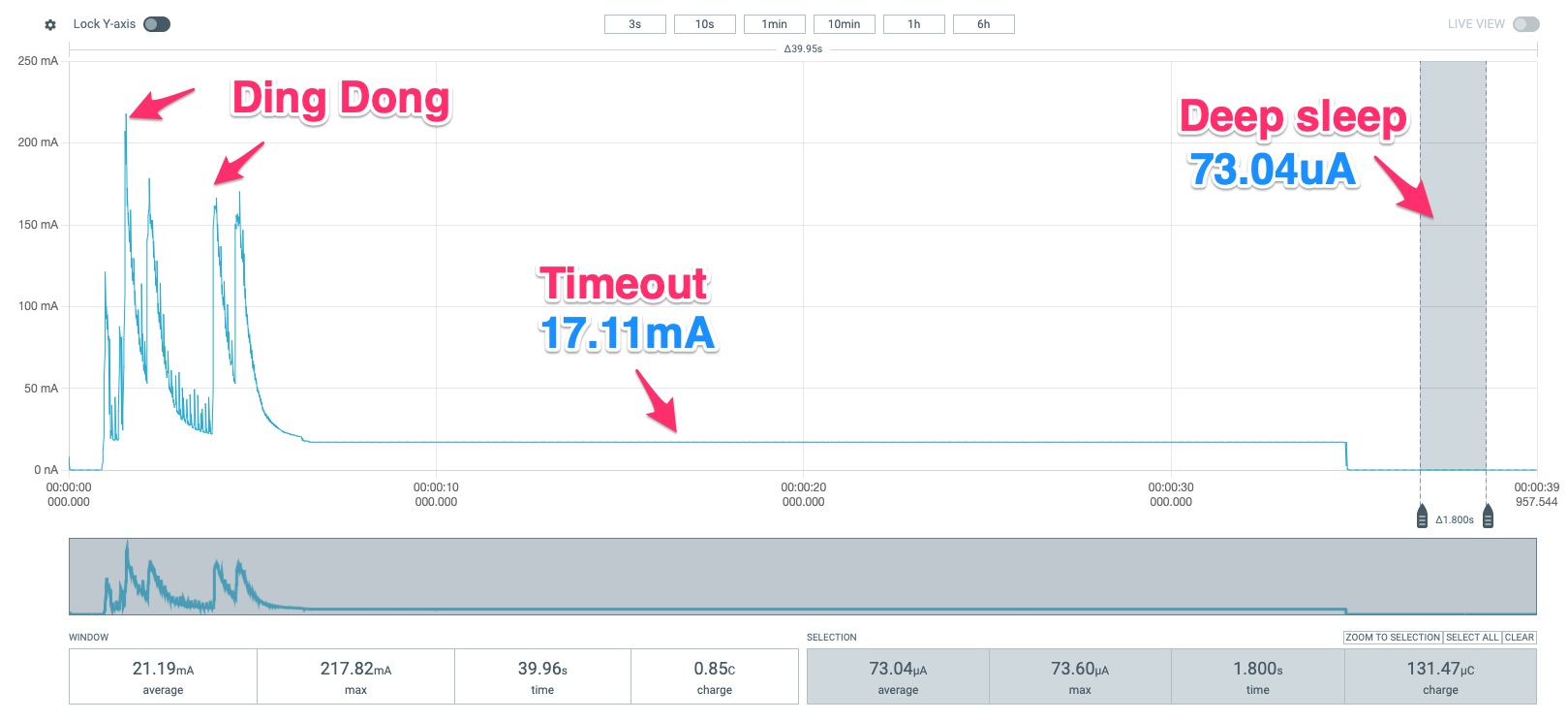1500mAh Rechargeable 16320 battery
🫑 A retrofitted wired audio doorbell with added WiFi connectivity 🔔
Power source
1500mAh Rechargeable 16320 battery
Battery life
Charging duration
Using nRF Power Profiler PPk2, the power consumption of the PCB can be measured. Follow a simpler ESP32-C3 dev board tutorial to learn how to use PPK2.
The average power consumption of the PCB no optimisation:
The average power consumption is:
3.87mA in deep sleep mode25.69mA for 30s during the timeout after the bell is pressed and the Ding Dong sound is played31.94mA for 34s during the entire cycle of the bell press and going to sleep70.62mA for 6s during the Ding Dong soundFirmware and hardware optimisation can be done to reduce the power consumption:
WiFi.disconnect(true); and WiFi.mode(WIFI_OFF);The average power consumption of the PCB with optimisation:
73.04uA in deep sleep mode17.11mA for 30s during the timeout after the bell is pressed and the Ding Dong sound is played24.93mA for 34s during the entire cycle of the bell press and going to sleep63.99mA for 6s during the Ding Dong soundDownload nRF PPK2 file with no LED
Download nRF PPK2 file with no LED and radio/WiFi

Based on the above values, the battery life can be calculated with this python code:
Estimated battery life: 410.14 days or 1.12 years
# Constants
number_of_doorbell_rings = 5 # Number of doorbell rings per day
battery_capacity_uAh = 1200000 # Battery capacity in µAh, converted from 1200mAh
consumption_high_uA = 24930 # High consumption in µA, converted from 32mA
consumption_low_uA = 73 # Low consumption in µA
high_consumption_duration_s = 34 # Duration of high consumption in seconds
total_day_seconds = 86400 # Total seconds in a day
high_consumption_duration_s = high_consumption_duration_s * number_of_doorbell_rings # Multiply by the number of doorbell rings
# Calculate the total consumption in µAh for each period
high_consumption_total_uAh = consumption_high_uA * high_consumption_duration_s / 3600 # Convert seconds to hours
low_consumption_duration_s = total_day_seconds - high_consumption_duration_s
low_consumption_total_uAh = consumption_low_uA * low_consumption_duration_s / 3600 # Convert seconds to hours
# Calculate the total average daily consumption in µAh
average_daily_consumption_uAh = high_consumption_total_uAh + low_consumption_total_uAh
# Calculate the battery life in days
battery_life_days = battery_capacity_uAh / average_daily_consumption_uAh
# Calculate the battery life in years
battery_life_years = battery_life_days / 365
# Echo out the values
print(f"Estimated battery life: {battery_life_days:.2f} days or {battery_life_years:.2f} years")The battery measurement circuit is simulated in Falstad.
$ 1 0.000005 5.023272298708815 78 5 50 5e-11
172 224 240 176 240 0 7 0 3.3 0 0 0.5 Gate Voltage
w 352 224 352 176 1
f 288 240 352 240 33 1.5 0.02
R 352 176 352 144 0 0 40 4.2 0 0 0.5
c 224 240 288 240 0 0.1 0.000999999998577626 0.001
r 288 192 336 192 0 1000000
w 336 192 352 192 0
w 288 192 288 240 0
g 352 352 352 368 0 0
r 352 256 352 304 0 100000
r 352 304 352 352 0 100000
w 352 304 256 304 0
o 2 64 0 4099 0.001220703125 0.00009765625 0 2 2 3
With a p-channel MOSFET, when the gate voltage is 0V or LOW, the battery voltage is measured. When the gate voltage is 3.3V or HIGH, the battery voltage cannot be measured.
The battery is charged with a USB-C cable. Plug in the USB-C cable to a power socket on-the-wall or a power bank.